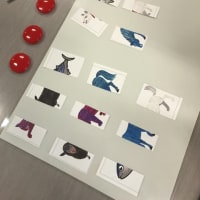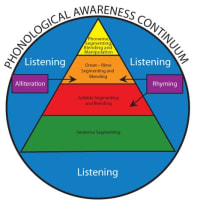October 12, 2009記事から
日本語は、ひらがな、カタカナ、漢字とあるが、
それぞれに脳の異なる部分を使うため、難しさが違うということがわかる。
「ひらがなができるのに、漢字がだめな子」
や、
「なぜかアルファベットがだめな子」
の弱さの理由がわかれば、音韻認識に働きかける指導法を取ればいいのか、
形を捉える(これはビジョントレーニングができる)力を強くする指導が必要なのか、
指導側が理解しながら子どもの読み書き指導に当たることができる。
最新の科学的知識からアプローチを考える。
(要約)
ディスレクシアといっても、中国と英語圏では異なる。
英語圏の発達性ディスレクシアは、は視覚性よりは、音韻性の問題(文字と音を対応させる力が弱い)であることが多い。
では、文字が表音文字ではなく、すべて表意文字であった場合はどうだろうか?
中国のディスレクシア児の脳の研究から、音と視覚認知の両方の問題がそれぞれ検出された。
中国語のディスレクシア児は、形を正確に認識し、音と意味につなげる力が必要である。
Chinese dyslexia may be much more complex than the English variety, according to a new paper published online today in Current Biology. English speakers who have developmental dyslexia usually don’t have trouble recognizing letters visually, but rather just have a hard time connecting them to their sounds.
What about languages based on full-word characters rather than sound-carrying letters? Researchers looking at the brains ofdyslexic Chinese children have discovered that the disorder in that language often stems from two separate, independent problems: sound and visual perception.
The pronunciation of detailed and complex Chinese characters must be memorized, rather than sounded out like words in alphabet-based languages. That requirement led researchers to suspect that disabilities in the visual realm might come into play in dyslexia in that language. "A fine-grained visuospatial analysis must be preformed by the visual system in order to activate the characters’ phonological and semantic information," said lead author Wai Ting Siok of the University of Hong Kong, in a prepared statement.
To see whether Chinese dyslexics had trouble comprehending visual details, researchers used functional magnetic resonance imaging (fMRI) to study the brains of 12 Chinese children with dyslexia. When asked to complete a task that involved visually judging size, the dyslexic children had less activation in an area of the brain that is charged with visual-spatial processing (the left intraparietal sulcus) than did Chinese children with normal reading levels. Previous research had also shown that the dyslexic group had weak activation in areas that process phonological information (the left middle frontal gyrus) when tested with a rhyming task.
Because of the two processes—aural and visual—that must come together for Chinese literacy, Siok concluded in the statement: "Disordered phonological processing may commonly coexist with abnormal visuospatial processing in Chinese dyslexia."
The new confirmation may eventually have ramifications for the way Chinese students with dyslexia are helped. But in the meantime, more research and investigation into the field of character-based language dyslexia must be completed. As she added: "Our results strongly indicate the need for a unifying theory of a sufficient scope to accommodate the full complexity of the observed dysfunctions and interactions of the brain systems underlying reading impairments."
Image of child with Chinese writing (unrelated to study) courtesy of Catsper via Flickr





















※コメント投稿者のブログIDはブログ作成者のみに通知されます